Abstraction in Spatial Drawing
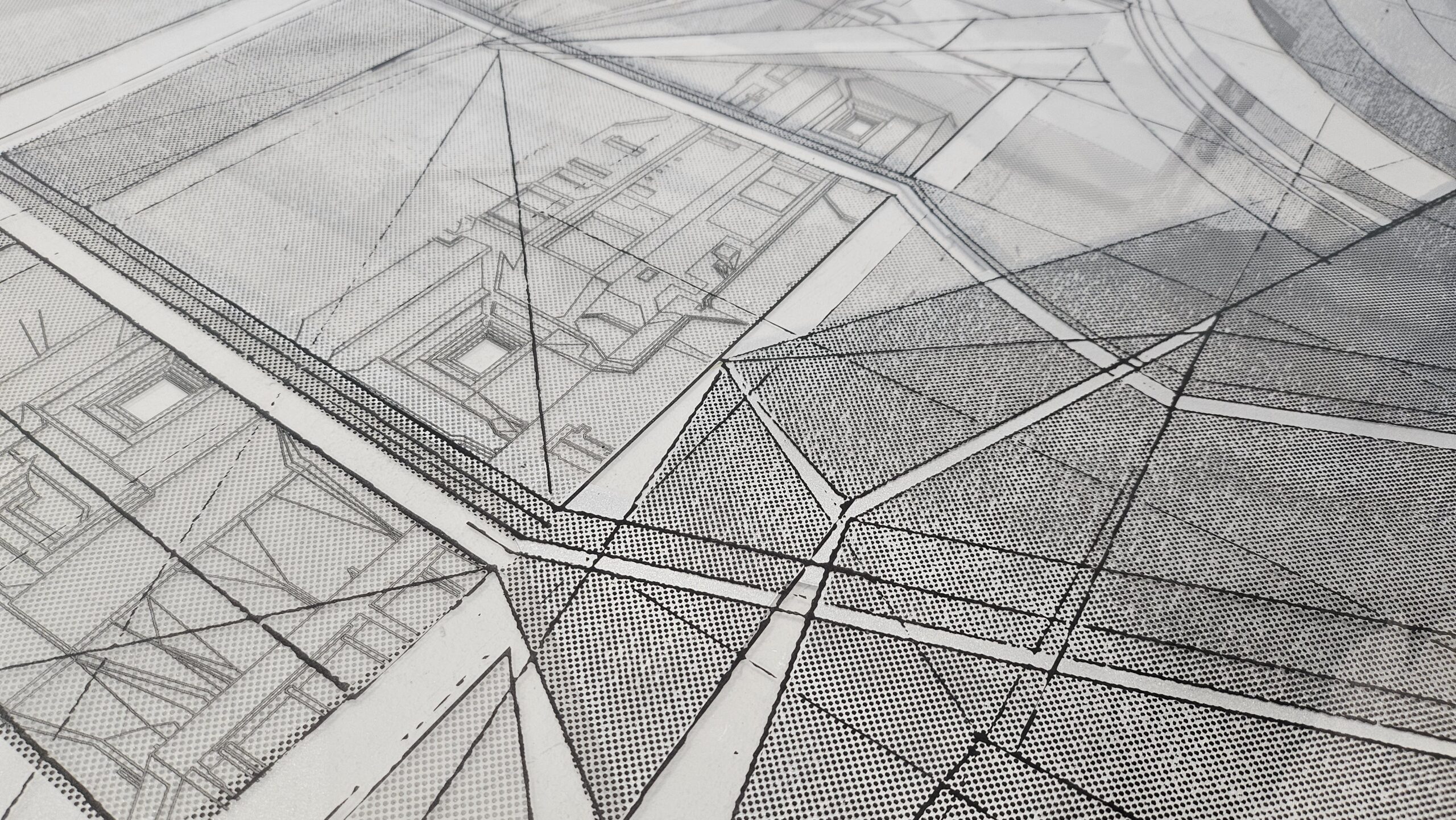
Summary
A 20-minute exercise in abstracting an internal or external space.
This Open Educational Resource is openly licensed and provides a structured method for transforming a spatial drawing into an abstract composition with multiple perspectives.
Learning outcomes:
Understand and apply a systematic approach to the abstraction of a drawing of a space.
Gain confidence in independent exploration and decision making when exploring abstraction.
(Optional) Develop critical observation and analysis skills in relation to spatial environments.
Introduction
The activity will teach you a practical, repeatable method for abstracting a real space. You will follow a set of steps to produce a rough piece of work, which you may then choose to refine or use as a basis for further experimentation. You may either work digitally or on paper, which can aid in producing work with different qualities.
The aim of this OER is allow you to experiment with technique, not necessarily to complete a finished piece of work. However, optional steps will be included at the end if you wish to spend longer on this project.
The method will encourage you to consider how artists translate spaces, architectural forms, and spatial perceptions through abstraction. You will begin with an observational drawing, then onto the method, and finally reflection.
Materials required (paper method): Device with photo taking capabilities, pencil, eraser, paper, tracing paper, printer (optional).
Materials required (digital method): Device with photo taking capabilities, computer, or tablet, drawing software (e.g. Clip Studio Paint, Photoshop, Procreate etc.), drawing tablet or digital pen (optional).
Estimated time: 20 minutes.
Step 1: Choosing your space
Before starting your drawing, you will decide on which space you wish to observe.
Spaces which make good candidates for this method tend to have:
- Strong structural elements (columns, doors, windows, balconies, multiple levels, fences).
- Visual depth and overlapping elements.
- Visual contrast (e.g. dense vs. open, structures near and far).
- Personal meaning or conceptual interest (if you are creating a piece for a certain project, you might want to consider if this place can tie in with your theme or concept).
The space you choose could be a supermarket, a multi-story car park, a street corner, a shop, or your kitchen. Avoid using spaces with a lot of foliage such as a garden and focus more on spaces with strong architectural forms like buildings and streets. I have found that the spaces which yield the most interesting results tend to be those with windows, doors, and staircases. For the purposes of this resource – choose a smaller space, or you may spend too much time on the observational drawing.
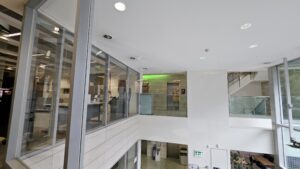
Floraidh Clark, CC BY-NC
Photo of multi-level library space (Evolution House library, Edinburgh University)
Observe the space
Spend 60-90 seconds noticing:
- How your eye moves through the space
- Major directional lines
- Repeated patterns or shapes
- Negative space
Take a photo of the space you have chosen. You may print this if you wish to trace your drawing.
Step 2: Draw or trace your photo
2-3 minutes
Make a quick sketch or trace your space onto your tracing paper, or digital software if using the digital method.
- Only capture the main lines of the drawing
- Avoid trivial details such as objects on tables.
- Do not use any shading.
- Keep lines clean, with a consistent line weight throughout.

Floraidh Clark, CC BY-NC
Drawn using Clip Studio Paint
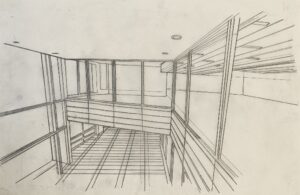
Floraidh Clark, CC BY-NC
Traced using pencil
Step 3: Abstraction
10-15 minutes
- Digital Method
- Highlight your entire spatial drawing and reduce size so that it is the size of around a quarter of the page.
- Duplicate the drawing and repeat it randomly 2-3 times, you may shrink, rotate either 90 or 180 degrees, and flip it.
- Connect all lines at edges of each drawing to the neighbouring drawing.
- Look for intersections,
- Extend drawing edges,
- Create new dialogue between shapes.
The merging of these drawings will create an abstract structure which will create new shapes and transform existing ones.
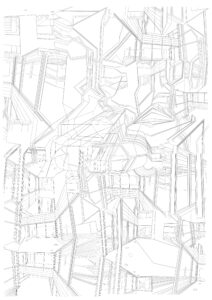
Floraidh Clark, CC BY-NC
Completed digital drawing using abstraction method
- Pencil Method
- Place tracing paper with your drawing onto your larger sheet of paper with the side you drew on face down. Trace over the lines in your drawing to transfer them onto the sheet.
- Transfer the drawing 2-3 times onto the same sheet, rotating 90 or 180 degrees. For this method, you may also wish to transfer some lines over the top of an already transferred drawing (but do this sparingly).
- With your pencil, connect the lines at the edges of the drawings to each other, forming one whole unified space.
- Look for intersections,
- Extend drawing edges,
- Create new dialogue between shapes.
The merging of these drawings will create an abstract structure which will create new shapes and transform existing ones.
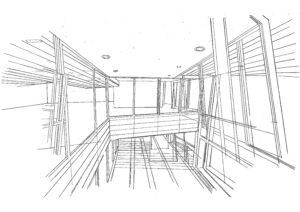
Floraidh Clark, CC BY-NC
Outcome using pencil and tracing paper, drawings layered
Step 4: Reduction
Reduction sharpens the composition by removing unnecessary information.
Spend 2-3 minutes asking:
- Which lines are essential?
- Which forms create balance or rhythm?
- What distracts from the overall rhythm?
Erase lines which do not contribute to the overall abstract structure.
You will now have a finished experimental abstraction.
Step 5 (optional): Reflection, analysis, and progressions
Reflection will help connect your experimental piece to wider themes in Contemporary Art Theory.
Spend some time considering:
- What traces of the original space remain?
- What new spatial relationships have emerged?
- Does the final composition feel architectural, emotional, confusing, or structural?
- How many different perspectives can now be found in your completed space?
- Which aspects might you want to take further in a more refined piece?
Wider themes in Art Theory
You may wish to explore the following themes in relation to your work, and research artists and theorists who have worked with the following areas:
- Phenomenology
- Process-based abstraction
- Diagrammatic drawing
- Architectural abstraction
- Mult perspectivism
- World building
Refining your piece into a completed work
It is possible to ‘finish’ your work so that it can work as a polished piece. If you wish to do this, you could:
- Add areas of tone to create dimension, which may help to convince viewers that this is a tangible space.
- Change lines weights (consider if structures are nearer or further away).
- Further reduce larger compositions (consider printing a large-scale version of your drawing, create a paper ‘view finder,’ and place this over smaller areas of interest, isolating forms. Then, redraw this specific section of your drawing).
- Recreate your drawing with other materials (e.g. paint onto board, print onto different paper types or acetate, layer tracing paper to merge drawings, laser etch onto acrylic sheets, create 3D models of your space).
- Experiment with the method several times using different spaces or merge multiple spaces into one multi perspective drawing.
Abstraction in Spatial Drawing © 2025 by Floraidh L Clark is licensed under CC BY-SA 4.0


